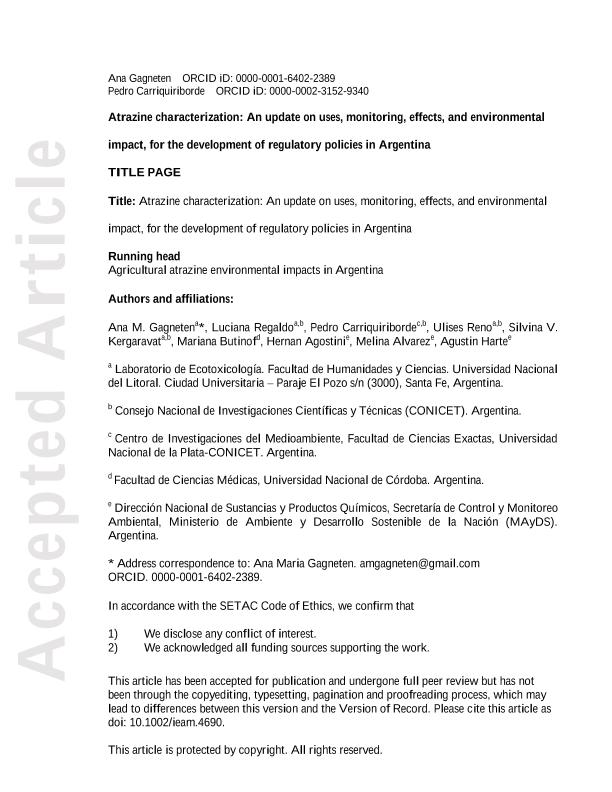Mostrar el registro sencillo del ítem
dc.contributor.author
Gagneten, Ana María

dc.contributor.author
Regaldo, Luciana María

dc.contributor.author
Carriquiriborde, Pedro

dc.contributor.author
Reno, Ulises

dc.contributor.author
Kergaravat, Silvina Vanesa

dc.contributor.author
Butinof, Mariana

dc.contributor.author
Agostini, Hernán Javier

dc.contributor.author
Alvarez, Melina Andrea

dc.contributor.author
Harte, Agustin
dc.date.available
2023-08-10T18:06:52Z
dc.date.issued
2022-09
dc.identifier.citation
Gagneten, Ana María; Regaldo, Luciana María; Carriquiriborde, Pedro; Reno, Ulises; Kergaravat, Silvina Vanesa; et al.; Atrazine characterization: An update on uses, monitoring, effects, and environmental impact, for the development of regulatory policies in Argentina; John Wiley & Sons; Integrated Environmental Assessment and Management; 19; 3; 9-2022; 684-697
dc.identifier.issn
1551-3777
dc.identifier.uri
http://hdl.handle.net/11336/207854
dc.description.abstract
Atrazine (ATZ) is the third most widely used herbicide in Argentina (10 000 t year−1) and is approved for sugar cane, flax, corn, sorghum, and tea. An assessment of the ATZ environmental impacts was conducted at the request of the Ministry of Environment and Sustainable Development of Argentina. A review of 541 national and international technical and scientific reports and a survey among agricultural technicians, applicators, and producers was done. The survey revealed that 94% of ATZ applications are terrestrial and use diversion exists, associated mainly with soybean cultivation. Atrazine was reported at high frequencies (50%–100%) in surface and groundwater, sediments, and soils, sometimes exceeding permitted limits. Several sublethal effects induced by ATZ on invertebrate and vertebrate species were found, sometimes at concentrations lower than those in water quality guidelines (<3 µg L−1) or the environmental concentrations found in Argentina. Available epidemiological or human health studies of local populations are extremely scarce. This assessment also demonstrated that herbicides are ubiquitous in the environment. The investigation highlights the need for further studies assessing the adverse effects of ATZ on local species, ecosystems, and human health. Therefore, the precautionary principle is recommended to promote better application standards and product traceability to reduce volumes entering the environment and to avoid use deviation. In addition, this work concluded that there is a need for reviewing the toxicological classification, establishing buffer zones for ATZ application, introducing specific management guidelines, and expanding local studies of toxicity, ecotoxicity, and human epidemiology for environmental and health risk assessments. This study could also serve as a preliminary risk evaluation for establishing a final regulatory action and for considering ATZ inclusion in Annex III of the Rotterdam Convention. Finally, the requirements to consider its inclusion in Annex A (Elimination) or B (Restriction) of the Stockholm Convention were evaluated and discussed, and information on the potential of long-range transport was the only criterion with no information to consider.
dc.format
application/pdf
dc.language.iso
eng
dc.publisher
John Wiley & Sons

dc.rights
info:eu-repo/semantics/openAccess
dc.rights.uri
https://creativecommons.org/licenses/by-nc-sa/2.5/ar/
dc.subject
ARGENTINA MONITORING
dc.subject
ATRAZINE ENVIRONMENTAL IMPACT AND EFFECTS
dc.subject
DECISION ANALYSIS
dc.subject
ROTTERDAM CONVENTION
dc.subject
STOCKHOLM CONVENTION
dc.subject.classification
Otras Ciencias de la Tierra y relacionadas con el Medio Ambiente

dc.subject.classification
Ciencias de la Tierra y relacionadas con el Medio Ambiente

dc.subject.classification
CIENCIAS NATURALES Y EXACTAS

dc.title
Atrazine characterization: An update on uses, monitoring, effects, and environmental impact, for the development of regulatory policies in Argentina
dc.type
info:eu-repo/semantics/article
dc.type
info:ar-repo/semantics/artículo
dc.type
info:eu-repo/semantics/publishedVersion
dc.date.updated
2023-08-08T12:44:58Z
dc.identifier.eissn
1551-3793
dc.journal.volume
19
dc.journal.number
3
dc.journal.pagination
684-697
dc.journal.pais
Estados Unidos

dc.journal.ciudad
California
dc.description.fil
Fil: Gagneten, Ana María. Universidad Nacional del Litoral. Facultad de Humanidades y Ciencias. Laboratorio de Ecotoxicologia; Argentina
dc.description.fil
Fil: Regaldo, Luciana María. Universidad Nacional del Litoral. Facultad de Humanidades y Ciencias. Laboratorio de Ecotoxicologia; Argentina. Consejo Nacional de Investigaciones Científicas y Técnicas. Centro Científico Tecnológico Conicet - Santa Fe; Argentina
dc.description.fil
Fil: Carriquiriborde, Pedro. Universidad Nacional de La Plata. Facultad de Ciencias Exactas. Centro de Investigaciones del Medio Ambiente - Consejo Nacional de Investigaciones Científicas y Técnicas. Centro Científico Tecnológico Conicet - La Plata. Centro de Investigaciones del Medio Ambiente; Argentina
dc.description.fil
Fil: Reno, Ulises. Universidad Nacional del Litoral. Facultad de Humanidades y Ciencias. Laboratorio de Ecotoxicologia; Argentina. Consejo Nacional de Investigaciones Científicas y Técnicas. Centro Científico Tecnológico Conicet - Santa Fe; Argentina
dc.description.fil
Fil: Kergaravat, Silvina Vanesa. Universidad Nacional del Litoral. Facultad de Humanidades y Ciencias. Laboratorio de Ecotoxicologia; Argentina. Consejo Nacional de Investigaciones Científicas y Técnicas. Centro Científico Tecnológico Conicet - Santa Fe; Argentina
dc.description.fil
Fil: Butinof, Mariana. Universidad Nacional de Córdoba; Argentina
dc.description.fil
Fil: Agostini, Hernán Javier. Secretaría de Ambiente y Desarrallo Sustentable de la Nación; Argentina
dc.description.fil
Fil: Alvarez, Melina Andrea. Secretaría de Ambiente y Desarrallo Sustentable de la Nación; Argentina. Consejo Nacional de Investigaciones Científicas y Técnicas; Argentina
dc.description.fil
Fil: Harte, Agustin. Secretaría de Ambiente y Desarrallo Sustentable de la Nación; Argentina
dc.journal.title
Integrated Environmental Assessment and Management
dc.relation.alternativeid
info:eu-repo/semantics/altIdentifier/url/https://onlinelibrary.wiley.com/doi/10.1002/ieam.4690
dc.relation.alternativeid
info:eu-repo/semantics/altIdentifier/doi/http://dx.doi.org/10.1002/ieam.4690
Archivos asociados
